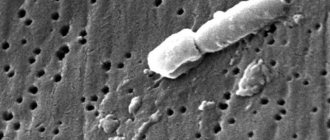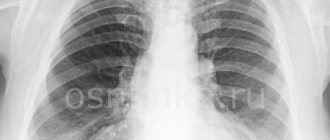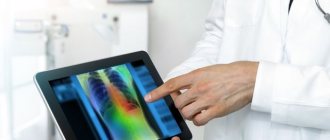Pneumonia is a serious disease, which in the absence of timely treatment can lead to a number of serious complications, and in advanced cases poses a danger to the patient’s life.
Therefore, at the first signs of the disease in the form of cough, fever, it is imperative to seek medical help. Doctors at the Yusupov Hospital will conduct an examination, a number of diagnostic procedures, make a diagnosis and prescribe an effective course of treatment.
Typically, pneumonia occurs as a complication of a cold. The first symptoms of pneumonia are very similar to the signs of acute respiratory infections. Weakness, cough and fever may indicate pneumonia. Initially, the temperature rises above 38 degrees only in the evening. In the morning it is within normal limits. In people with high immunity, this condition can occur for about two weeks. In this case, the patient is constantly bothered by a dry cough.
As the disease develops, the pulmonary temperature rises sharply to 40 degrees, the cough becomes wet, sometimes with blood, shortness of breath and pain in the chest area appear. Timely diagnosis of the disease and timely treatment can quickly relieve the patient from the pronounced symptoms of pneumonia and the disease itself.
Under no circumstances should you self-medicate and lower your temperature below 38 degrees. Very low temperatures, as well as too high temperatures, aggravate the course of the disease. Doctors at the Yusupov Hospital recommend lowering it to a certain norm.
Causes of pneumonia
Almost always, an inflammatory reaction in the lung tissue is caused by an infection. Pneumonia can be caused by many microorganisms - bacteria (most often), viruses, fungi and even some types of protozoa. In the vast majority of cases, the cause of pneumonia is:
- streptococcus pneumoniae - pneumococcus;
- chlamydia;
- haemophilus influenzae - hemophilus influenzae;
- respiratory syncytial virus is the most common cause of viral pneumonia
- other types of streptococci;
- staphylococci;
- mycoplasma.
Sometimes pneumonia can also be non-infectious and be caused by:
- toxic lesions of lung tissue;
- allergic reactions;
- autoimmune diseases;
- exposure to extreme temperatures;
- penetrating radiation (cancer patients undergoing radiation therapy to the lungs).
Risk factors
Predisposing factors for the occurrence of inflammation in the lung tissue are:
- chronic diseases of the endocrine, cardiovascular and respiratory systems;
- disturbances in the functioning of the immune system;
- bad habits (primarily smoking);
- malformations of the respiratory system;
- sedentary lifestyle.
Severe cases of the disease occur especially often in older people over the age of 65. Pneumonia is also extremely dangerous in newborns and children of primary school age. It is these categories of patients that account for the vast majority of deaths.
Types of pneumonia
According to the prevalence of the process, pneumonia can be:
- focal, affecting only a small area;
- segmental, spreading to one or more segments of the lung;
- lobar, occupying the entire lobe of the lung;
- total, with damage to the entire lung.
The disease is classified according to its causes:
- bacterial pneumonia;
- viral pneumonia;
- mycopneumonia;
- mixed types, in which massive infection with various microorganisms leads to inflammation of the lung tissue.
In addition, there are unilateral (affecting one lung) and bilateral pneumonia (affecting both lungs). Based on the duration of the course, there are acute forms, lasting up to 3 weeks, and subacute forms, lasting from 3 to 6 weeks. Finally, depending on the severity of symptoms, pneumonia can be mild, moderate, or severe, and may or may not have complications (primarily heart and/or respiratory failure).
Treatment at the Yusupov Hospital
Pneumonia is a rather complex and unpredictable disease that requires compliance with all doctor’s instructions, thanks to which it is possible to prevent a sharp deterioration in the patient’s well-being and aggravation of the disease.
Yusupov Hospital in Moscow offers high-quality diagnostics and effective treatment of pneumonia. The specialists of our clinic, whose competence is confirmed by international certificates, will provide comprehensive support until the patient’s complete recovery.
Thanks to the clinic being equipped with modern diagnostic and treatment equipment, our doctors have the opportunity to obtain the most reliable research results and select a treatment method for pneumonia that is most effective for a particular type of disease.
The Yusupov Hospital has its own hospital, where patients can expect comfortable rooms, good nutrition, round-the-clock staff assistance and an individual approach. You can make an appointment with a doctor by calling the clinic.
Signs of pneumonia
The standard clinical picture of pneumonia is characterized by symptoms:
- Sudden onset.
- A sharp rise in body temperature above 38 0C.
- Rapid onset of cough with sputum production.
This is how almost all bacterial and viral pneumonias begin, including the most common variants caused by pneumococcus. As the disease progresses, the symptoms include shortness of breath and painful, often stabbing, sensations in the chest. Such symptoms can persist in the patient for up to 2 weeks.
The modern clinical picture of community-acquired pneumonia can vary widely and be “erased” due to the uncontrolled use of antibacterial drugs. Has symptoms of respiratory infections:
- your health will deteriorate over several days;
- dry cough with virtually no phlegm;
- headache;
- increased weakness and fatigue;
- muscle soreness;
- pain and sore throat.
How many days does a fever last for pneumonia?
With pneumonia, a temperature of up to 39 degrees can persist for up to three days until the antibiotics prescribed by the doctor begin to take effect. In case of development of bilateral pneumonia, a temperature of up to 38 degrees can persist for up to two weeks. Such patients should be under the close supervision of a physician.
In the inpatient conditions of the Yusupov Hospital, the patient’s condition is monitored by highly qualified doctors, which makes it possible to exclude the development of complications. Also, if necessary, the doctor can always adjust the course of treatment and prescribe the necessary procedures for a speedy recovery.
The atmosphere in the wards of the Yusupov Hospital bears little resemblance to the atmosphere of state hospitals. All conditions have been created here to make the patient feel as comfortable as possible. All rooms are equipped with modern furniture and equipment, and have access to WI-FI. Each room has a private bathroom. The patient can always call a medical professional into the room using the call button.
Sometimes pneumonia can occur in the body without an increase in body temperature. In this case, the patient may not even suspect a serious illness. As a rule, with this development of the disease, the temperature subsequently rises very rapidly and reaches high limits. In this situation, the patient needs the help of a specialist. It is almost impossible to stop the development of the disease on your own.
It is impossible to say for sure how long the temperature lasts during pneumonia. Everything is individual and depends on many factors.
Expert opinion
More than 1 million cases of pneumonia are diagnosed annually on our planet.
Moreover, almost 8.5% of them are fatal. Of course, the vast majority of such adverse outcomes occur in groups at risk for pneumonia: children under 5 years of age and elderly people over 65 years of age. However, even if you are young and healthy, neglecting pneumonia is extremely dangerous. At the first manifestations of this disease, you should immediately consult a doctor and under no circumstances self-medicate. Pulmonologists at SM-Clinic will make a diagnosis as quickly as possible, determine what exactly caused pneumonia and prescribe the necessary therapy. It will include modern highly effective drugs and techniques, and will be built in accordance with the clinical recommendations of the Russian Respiratory Society and the Interregional Association for Clinical Microbiology and Antimicrobial Chemotherapy, approved by the Ministry of Health of the Russian Federation and WHO recommendations.
Savina Maria Yuryevna, pulmonologist at SM-Clinic in Ryazan
How to eliminate fever after pneumonia?
Until the cause of the increase in body temperature after pneumonia is determined, patients are not prescribed antipyretic drugs. They can mask the true clinical picture of the disease. Patients are advised to drink up to 2.5 liters of fluid per day. This helps remove toxins from the body. Preference should be given to purified water, raspberry and cranberry juice. Linden tea with honey has a good antipyretic effect.
Patients are advised to avoid contact with infectious patients and take walks in the fresh air. You should not overcool and avoid drafts. In most cases, after suffering from pneumonia, the temperature drops to normal levels on its own.
If the doctors at the Yusupov Hospital determine that the increase in temperature is a complication of pneumonia, they prescribe treatment for the corresponding pathology. To increase the overall reactivity of the body, immunomodulators are used:
- interferon;
- levamisole;
- zymosan;
- diuciphone;
- t-activin;
- Thymalin.
To prevent viral infections, it is recommended to inhale phytoncides. In order to restore the body's nonspecific resistance, vitamin and mineral complexes are prescribed, biogenic stimulants and adaptogenic agents are used (schizandra and ginseng tinctures, aloe juice, liquid extract of Eleutherococcus). Sometimes body temperature returns to normal after treatment of carious teeth or diseases of the ENT organs.
If you have a fever after pneumonia, call the Yusupov Hospital, where doctors will conduct an examination, identify the cause of the increase in body temperature and prescribe effective therapy. Pulmonologists take an individual approach to the treatment of each patient.
Treatment of pneumonia
The basis of treatment for pneumonia are drugs that act directly on the cause of the disease:
- antibiotics for bacterial infections;
- antiviral drugs for viral infection;
- antifungal agents for fungal invasion, etc.
The total duration of treatment of bacterial pneumonia with antibiotics averages from 7 to 10 days. For infection with mycoplasma or chlamydia, the course of treatment lasts at least 14 days. If pneumonia was caused by rarer pathogens (enterobacteria, legionella, etc.), then therapy can last 21 days or more. The criteria for stopping antibacterial treatment of pneumonia in adults are maintaining normal body temperature for 2-3 days, the absence of inflammatory symptoms and normalization of blood counts.
Also, for pneumonia, therapy is prescribed to alleviate the symptoms of the disease:
- drugs that dilate the bronchi and thin the sputum to clear the airways;
- corticosteroids;
- saline solutions to maintain water-salt balance;
- oxygen inhalation for respiratory failure;
- physiotherapy at the final stages of the disease (UV irradiation, vibration massage, physical therapy, etc.).
How to reduce fever with pneumonia
You can lower your body temperature only with medications that have been approved by your doctor. Only a doctor can determine the effectiveness of taking medications for pneumonia in each individual case. As a rule, mild antipyretic drugs are prescribed at temperatures above 38 degrees. To reduce fever in adult patients, the following medications are prescribed:
- ibuprofen;
- nurofen;
- paracetamol;
- aspirin;
- Citramon.
You can rub with a towel soaked in cool water or a water-vinegar solution, paying special attention to the temples, forehead, and bends of the arms and legs.
The patient can use folk remedies on his own. When it’s hot, a raspberry drink helps a lot; linden tea will increase sweating. Drinks made from honey, lemon, currants, rose hips, as well as citrus fruits contain large amounts of vitamin C, which improves immunity and serves as a good assistant in the fight against pneumonia.
Vaccination against pneumococcus
The most common cause of pneumonia is streptococcus pneumoniae (pneumococcus). A vaccine has already been developed against it and is widely used, which protects a person against 23 of the most common strains of pneumococcus. According to WHO, vaccination reduces the risk of developing pneumonia caused by this microorganism by more than 90%. In 2014, the PCV vaccine (pneumococcal conjugate vaccine) became part of the national vaccination calendar of the Russian Federation. Its effectiveness does not depend on age, so this vaccination is recommended for all those born before 2014.
Breathing exercises
To prevent pneumonia
Today, the prevention of pneumonia is one of the most important in the complex of health practices and care for the condition of the human body. It has become obvious that lung damage is a real threat, much more widespread and urgent than it seemed to many of us just recently. The coronavirus pandemic has made adjustments not only to our way of life, but has also made it extremely important to take care of our respiratory system and its healthy and complete state.
One of the most effective ways to prevent pneumonia is regular breathing training with the Samozdrav simulator. And there are justified reasons for this and many years of indisputable evidence.
Breathing exercises strengthen the respiratory muscles, which increases the mobility of the chest and diaphragm. Effective movements of the respiratory muscles increase the volume of the chest and lungs. This ensures maximum pulmonary ventilation and air circulation in the alveoli and increases the utilization rate of oxygen in the lungs and its delivery to the tissues.
Maintaining normal lung volumes and regular training of the respiratory muscles forms the correct respiratory rhythm. As a result of this, the respiratory rate, its minute volume and other indicators that are disturbed due to stress, physical inactivity, and chronic diseases are normalized. Physiologically correct breathing is maintained for a long time.
Breathing exercises maintain the elasticity of the lung tissue. This increases the vital capacity of the lungs and prevents the development of fibrosis and other changes in the lung tissue. CO2 eliminates bronchospasm, which also increases breathing efficiency.
Breathing training increases the efficiency of the pulmonary circulation. This is especially important for older people, because one of the common causes of pneumonia in the elderly is stagnation of blood in the small circle.
As a result of restoration of the functions of the respiratory system and blood circulation, the inflammatory process is reduced, congestion in the bronchi and lungs is prevented, and mucus and exudate are reabsorbed.
In addition, Samozdrav compensates for the lack of physical activity, and breathing training, like physical exercise, promotes the production of a natural antioxidant (superoxide dismutase), which prevents the development of pneumonia.
All these arguments are the result of numerous in-depth studies related to the study of the effect of breathing training with Samozdrav on human lungs and the prevention of pneumonia, as well as the experience of people of different ages and different levels of health.
Today, millions of people from around the world train with Samozdrav to prevent the development of pneumonia - one of the main dangers to the body during a pandemic.
If you want to get one of the most effective ways to take care of your respiratory system, an indispensable assistant for the prevention of pneumonia, purchase the Samozdrav breathing simulator. Years of experience have proven its effectiveness, accessibility and the highest results in maintaining lung health.
For rehabilitation after pneumonia
During a difficult period of threats of a high viral load on the body, it is important to know how to quickly get back into shape after pneumonia and allow your lungs to work at full strength again. Firstly, it is important to follow the general rules of caring for yourself and your health. Sleep at least 8 hours at night and a couple of hours during the day, eat well, not forgetting vitamins A, B, C and calcium, ventilate the room every three hours.
Particular attention should be paid to your lungs, devoting time to breathing exercises to improve pulmonary circulation and strengthen the pulmonary muscles. Through breathing training with the Samozdrav simulator, exudate will be absorbed, sputum separation will be facilitated, the airways will be cleared, lung tissue will remain healthy and elastic, tissue metabolism will be normalized and intoxication that accompanies the acute stage of the disease will be eliminated. Healthy breathing and normal inspiratory volume will be restored, shortness of breath will go away due to the normalization of oxygen levels in the body,
In the process of breathing training with the Samozdrav simulator, rehabilitation after pneumonia will be successful, it will be quick and comfortable, and you will be able to regain your vital energy in a natural way - by training through correct and healthy breathing.
List of scientific literature used:
- Lai CC, Shih TP, Ko WC, Tang HJ, Hsueh PR Severe acute respiratory syndrome coronavirus 2 (SARS-CoV-2) and coronavirus disease-2019 (COVID-19): The epidemic and the challenges. International Journal of Antimicrobial Agents. March, 2020, 55 (3): 105924.
- Marchello CS, Ebell MH, Dale AP, Harvill ET, Shen Y., Whalen CC Signs and Symptoms That Rule out Community-Acquired Pneumonia in Outpatient Adults: A Systematic Review and Meta-Analysis.” Journal of the American Board of Family Medicine. April, 2021, 32 (2): 234–247.
- Metlay JP, Waterer GW, Long AC, Anzueto A, Brozek J, Crothers K, et al. Diagnosis and Treatment of Adults with Community-acquired Pneumonia. An Official Clinical Practice Guideline of the American Thoracic Society and Infectious Diseases Society of America. American Journal of Respiratory and Critical Care Medicine. October, 2021, 200(7): e45–e67.
- Pneumonia. Mayo Clinic Staff. Patient Care & Health Information. Mayo Clinic. Last reviewed: August, 2, 2021.
- Who Is at Risk for Pneumonia? US Department of Health & Human Services. The National Heart, Lung, and Blood Institute. Last reviewed: March 3, 2021.
- Pneumonia. News bulletin. World Health Organization. July 25, 2021.
- Chuchalin A.G., Sinopalnikov A.I., Kozlov R.S., Avdeev S.N., Tyurin I.E., Rudnov V.A., Rachina S.A., Fesenko O.V. Russian Respiratory Society (RRO). Interregional Association for Clinical Microbiology and Antimicrobial Chemotherapy (IACMAC). Clinical guidelines for the diagnosis, treatment and prevention of severe community-acquired pneumonia in adults. Pulmonology. 2014, (4): 13-48.









